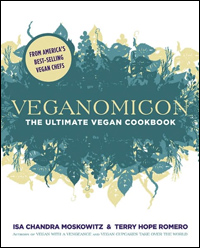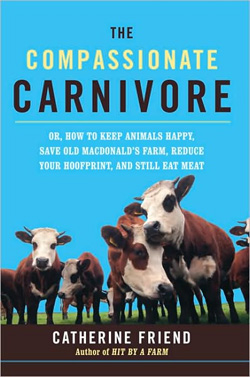If I live to be 80, I will be responsible for the deaths of 2,400 livestock animals (according to Michael W. Fox in his book Eating with Conscience). So will you, unless you’re one of those namby-pamby vegetarians.
Americans like meat, and a lot of it. We prefer for it to come without a face or any identifying markers that show it was a cow before being cut up, placed on a styrofoam tray, and wrapped in plastic. The preference for ignorance is easy to understand once you start reading about how that meat is raised, slaughtered, and processed – not to mention how what happens to that meat affects your own health. It can be difficult to reconcile yourself as a caring, compassionate human knowing the chicken you’re about to put in your mouth led a horrible, painful, tortured existence.
I know the arguments for going vegetarian. I was one for eight years, and I chanted these arguments while trying to chase away thoughts of thick steaks, steaks so rare they’re purple in the middle. First there’s factory farming — chickens debeaked, veal calves kept immobile, pigs so stressed and crowded they bite off each other’s tails. Farmers responded to these concerns by not only labeling their meat “organic” or “sustainable” or “free-range,” but also by creating Web sites, newsletters, CSAs, and farm tours to show people where their food is coming from. Next come the health reasons, of course. America is fat, charred beef has carcinogens, la dee dah. I have decided that life without aged ham, quail eggs, and those bloody steaks just isn’t worth living.
The newest argument for the pro-veggie diet is that raising livestock contributes to global warming. Yet most of the vegetarians I know drive cars, and I can feel vastly superior to them with my car-free lifestyle while I eat my grass-fed, locally raised, humanely slaughtered hamburger. Every so often, however, whatever it was that once possessed me to give up meat for so long starts making me feel guilty again. I begin to wonder if I do eat too much meat, even as careful as I am about the farms I buy from.
Health, the environment, and the well-being of animals are all very good reasons to be informed and smart about our decisions as consumers. What I have never understood, however, are the arguments for going vegan. When you’re a vegetarian, there is always someone around who is more hardcore than you. The vegans were always the most obnoxious at the drum circle. “I can’t believe you’re putting honey in your tea. Oh my god, that honey is for the bees. They made it, it’s theirs,” says the 85-pound hollowed-out girl wearing pleather sandals and a hemp skirt.
So I came to Veganomicon: The Ultimate Vegan Cookbook with a bit of an attitude problem. Authors Isa Chandra Moskowitz and Terry Hope Romero are the creators of Post Punk Kitchen, a Web site and online cooking show devoted to vegan cooking. I expected to be lectured and regaled with horror stories about cows skinned alive, human rights violations at slaughterhouses, or at least a gross-out reminder about what you’re eating when you eat an egg. Instead, Moskowitz and Romero are from the vegan cupcake movement — a happier, friendlier, less emaciated version of veganism. If you come for the vegan cupcakes, they think, maybe you’ll stay for the chickpea patties made with vital wheat gluten.
 |
I, however, missed the reactionary politics absent in Veganomicon because frankly, if anything convinces me to use fewer dairy products in my diet, it’ll be a guilty conscience and not vegan food. (Brown rice + meat substitute + stir fried zucchini = me making a KFC run in the middle of the night.) Even so, Veganomicon is a giant advancement from your typical dairy-free fare. The recipes all sound good. Double Pea soup with Roasted Red Peppers. Eggplant Rollatini with Spinach and Toasted Pine Nuts. Spaghetti Squash Mexicana with Tropical Avocado Salsa Fresca.
The recipes and photography were enticing enough for me to make a vegan feast and invite others. I refused to eat fake meat when I was a vegetarian, so I wasn’t about to start now, but still there were options (even if they included making “cashew cheese”). My friend started digging into the Crimini Walnut Pate as I finished up the Baked Pumpkin Ziti with Sage Breadcrumbs. I was beginning to regret forcing this food onto others as I dug into the vegan non-hydrogenated margarine. It was room temperature, but instead of smoothly curling into my spoon like lard or butter, it crumbled and curdled. It did not help that my friend appeared at my side after her first bite, saying, “Hey, where’s your salt?”
I handed it to her, but warned, “I already doubled the amount of salt in the recipe. I think that’s just the way it tastes.”
She vigorously shook salt into the bowl. She tested. “It’s a little better.”
Similar reactions followed the ziti and the dessert, Coconut-Lemon Bundt Cake. The ziti — which included the cashew cheese that I had to borrow a better food processor to make — got a lot of shrugs. The cake caused the pastry chef at the table to comment, “The texture is, um, interesting.” It was interesting in a spongy, almost right but not quite kind of way. Even with a better texture, it still only gave an impression of lemon and coconut. Without the butter and eggs to lay the foundation for the flavors, we could recognize the lemon and coconut, but it didn’t move us. The dish to get the most praise was the braised red chard, a recipe I made-up on the fly. That is perhaps the strangest thing about Veganomicon: There are not a lot of vegetable dishes. A lot of “choose a vegetable, add a soy product” dishes, but when you just want some greens to go with your pasta, the only option is a spinach and tomato dish that frankly sounded like a really bad idea.
I am willing to not lay blame fully at the feet at veganism itself. The vegan cassoulet I made from Veganomicon bizarrely called for cornstarch, which gave it a gummy texture, and the dried herbs and boiled potatoes did nothing to give it any real flavor. The vegan biscuits on top of the cassoulet were made with the same vegan margarine, and they tasted about like you’d expect a butter-free version of a food that is all about the butter would taste. I came across a vegan cassoulet in Gourmet later that week and decided to compare. (They called it “vegetarian,” as I’m sure the word “vegan” would scare of the sophisticates.) It used fresh herbs, breadcrumbs instead of vegan biscuits, and no thickener. It took the same amount of time and trouble, and yet afterwards I didn’t feel the compulsion to gnaw on parmesan rind just to satisfy my desire to taste something. Maybe one day vegans will get a master chef on their side who can create some food worth sacrificing for, but I’m guessing the movement does not attract people who feel passionately about food.
The reason for the boom in organic farming, free-range eggs, fair-trade coffee, and grass-fed beef is not that large corporations suddenly started worrying about the state of their souls. Executives at Burger King did not announce they would begin to buy their eggs and pork products from humane sources because they had a revelation about animal suffering. They did so because there is a growing demand in the marketplace. Vegans may think they’re alleviating the pain of livestock with their cupcakes and their textured vegetable protein, but the meat eaters are the ones making a difference.
Catherine Friend writes in her new book The Compassionate Carnivore: Or, How to Keep Animals Happy, Save Old MacDonald’s Farm, Reduce Your Hoofprint, and Still Eat Meat: “People who become complete vegetarians for the sake of animals are basically getting up from the table and leaving the room. Although they might work to help better animals’ lives through their words, those words won’t keep a sustainable farmer in business. Only dollars will. If you don’t buy from these farmers, they’ll go out of business, and you’ll have even fewer choices than you do now.”
The Compassionate Carnivore is a clear and direct handbook on how to make informed decisions when buying meat. Friend lays out all of the arguments that were missing from Veganomicon, and yet still she comes to the conclusion that one can be an animal lover and not cross over to vegetarianism. After all, a cruelty-free lifestyle should also be cruelty-free for the one living it. And forcing myself to eat biscuits made with vegan non-hydrogenated shortening for the rest of my life would just be mean. • 2 April 2008




